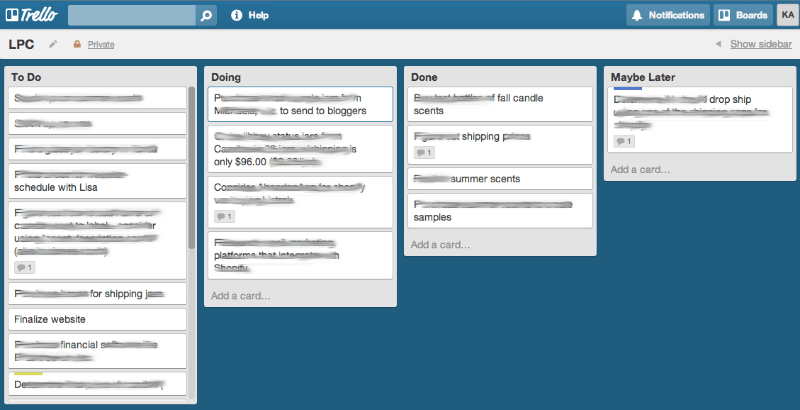Have you ever worked on a project where everything was seemingly going great…
Every few days, you’re meeting with your client to discuss your progress. Your project management tool is buzzing with activity. And your invoices are getting paid.
And then at the 11th hour, with the finish line is in sight, you get that call every consultant dreads:
“We need to talk.”
And then you panic. What the heck happened? Everything was going great… right?!
The client then rattles off a list of grievances:
This isn’t what they wanted. They’ve spent all this money and aren’t happy with what they’re getting. They don’t know why it looks the way it looks, functions the way it functions, or reads the way it’s written.
They’re unhappy.
 The other day I was listening to an episode of Bootstrapped with Kids, and Scott — one of the co-hosts who you might remember from episode 20 of my podcast — was talking about a few of these conversations he’s had with his clients, and how he’s gone about solving it.
The other day I was listening to an episode of Bootstrapped with Kids, and Scott — one of the co-hosts who you might remember from episode 20 of my podcast — was talking about a few of these conversations he’s had with his clients, and how he’s gone about solving it.
What Scott realized was that there’s a big difference between communicating and communicating.
Just because “stuff is happening” doesn’t mean that the client is able to tie together what they’re getting with what they’re paying. And if they’re unable to see the return-on-investment — that thing you promised them when selling them on working with you — then they often end up thinking that they’re wasting their time and money.
Scott ended up doing something relatively simple: he began supplementing all the stuff that was already happening (project management, client meetings, emails, etc.) with a brief, “CEO-ready” report that he sends to project stakeholders at the end of each week.
Part of my agency’s product was delivering these sort of reports to our clients. As an introverted business owner, I really didn’t like being on the receiving end of “we need to talk” calls, so I did everything in my power to eliminate them.
Like Scott, I realized that if I wasn’t constantly demonstrating the value I was producing for my clients, I was almost certainly setting myself up for failure.
I ended up arriving at my own version of a CEO-ready report for my agency, which is something I still do with my current clients.
Today, I’d like to show you how you too can create reports that demonstrate the value you’re bringing to the table.
“What value did I create this week?”
The first step is to try to catalog what you’re doing each week and, most importantly, what value these tasks have.
One of the topics I teach on in Double Your Freelancing Rate is to first determine where someone’s business is now, and then using Socratic questioning to find out where they need to be. The project and its requirements emerge from there — what needs to happen to go from here to there?
So when you know what needs to be completed for the project to be successful and the right amount of business value to be delivered, it should become fairly straightforward to judge how the work you’re doing each week is getting them closer to their target.

You’re most likely using some form of project / task management system like Trello, Basecamp, or Client Portal.
It depends on how you name the tasks, but chances are the data these tools have is technical — after all, these tools are meant to help you and the stakeholder collaborate over the work you’re doing.
What’s usually missing is how the parts make up the whole, even if it’s obvious or assumed.
How will this new dashboard feature get the client the traction they’re looking for?
Or the new about page you just designed — how does that get them the leads they need?
Spend some time compiling a list of what core things were accomplished this week, and what value was created.
It’s important to always be thinking, “How is this creating the value this business needs?”
That question should be the measure that weighs every task, every requirement, and every “…so I had this great idea last night” request from your clients.
Now that you’ve created a short, bulleted list of the value you created this week, you now need to distill it into something cohesive.
Provide a high-level summary
Not every client (or your client’s boss, if applicable) is going to care about everything that actually happened each week.
They just want to know that they’re getting their money’s worth and doing the right thing for their business. Don’t ever allow your clients to question otherwise.
To introduce each weekly report, write a paragraph or two that sums up the value that was created, how that fits into the big picture, anything you did that created an unexpected surplus of value, and what you’re planning on doing next.
Here’s an example from a website redesign for a mortgage company:
This week we broke ground on the lead generation form. This is the critical piece of the website, and what every other page — the home page, about page, etc. — points to. Rather than just embedding a form with all the information your business needs to sufficiently capture a lead, we did a little research on what form fields other mortgage brokers are using and what questions and field order are conducive to generating the most leads.
We’ve put into place a way to granularly track how effective the form converts, both independently and as a whole (e.g. what percentage of people who visit any given page on the website end up filling it out.) Since you’re planning on increasing your advertising budget, it’s critical that you have in place a way of tracking your total cost per lead, and having a way of testing alternate workflows and form designs to see whether that cost increases or decreases. What we’ve setup this week will allow you to continuously experiment and drive down the cost per lead over time, which is something your old website didn’t have.
Next week, we’re planning on setting up sitewide call-to-actions that will move more people to the lead capture page, relative to the type of information they’re currently viewing (for example, the call-to-action on a blog post on refinancing will be different than the call-to-action on the home page.)
Following these introductory paragraphs could follow a bulleted list of what tasks were accomplished, but in a lot of cases something as simple as the above is sufficient.
My favorite format for delivering these reports is email. If you want to up your professionalism, I highly recommend Remarq, which creates PDFs from Markdown.
In the Bootstrapped with Kids podcast episode, Brecht brought up an interesting idea: use a single Google Doc for these reports, and keep prepending weekly updates to this shared document. By the end of the project, the client will have a thorough report that walks them through the entire project, start-to-finish.
I like this idea, but I’m not the biggest fan of relying on Google to send document updates to anyone who has access to it. I’d send over my update via email and then link to the Google doc in each update email, stating that this update has been added to our ongoing project log.
And if you’re creating PDF reports with a tool like Remarq, you could archive all the weekly updates in a shared Dropbox folder.
Make reporting a part of your “product”
My agency made this level of reporting part of our product.
It was something we sold, and was a competitive advantage over our more risky competitors, especially fly-by-night freelancers who really had no formal process.
This addition, which took about 20 minutes a week to fulfill was responsible for helping us close more deals and virtually eliminate any 11th hour “we need to talk” calls. (If you’re still billing by the hour, you should be charging for this — always charge whenever you’re providing value. I bill by the week, so any of the project management or meeting overhead was rolled into one flat cost.)
This model of forced communication and transparency required our clients to stay engaged with the project. And there was no room for doubt — if a “he said, she said” situation came up, we could quickly and easily refer to project reports to quickly figure out who, if anyone, was at fault.
Many of you reading this are probably planning for changes you’re going to make to the way you do business in the coming fiscal year. I’d encourage you to try incorporating weekly reporting into your process.